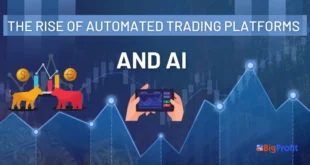Machine learning algorithms can be beneficial in quickly and accurately analyzing large amounts of data to detect trading patterns that people cannot see, then replicating them for intelligent trading strategies. They also automate trading processes while managing risks.
Quality data used in training a machine learning strategy is of utmost importance. A high-quality dataset is necessary to avoid overfitting and other problems associated with machine learning algorithms. Furthermore, an efficient data cleaning and preprocessing procedure must also be implemented to guarantee quality results.
Machine learning
Machine learning techniques have quickly gained prominence within the trading industry as an automated and improved means to market analysis. From using supervised algorithms that analyze labeled historical market data to unsupervised models that identify clusters and relationships, these technologies help traders make informed decisions while optimizing returns.
This book provides an in-depth, hands-on introduction to developing an algorithmic trading strategy from start to finish. You will learn how to source, manage, engineer predictive features using industry standard Python data ecosystem. Once collected you’ll use them to train a gradient boosting ML model before assessing its performance.
Machine learning algorithms are only as good as the data they’re trained on, which is why it is essential to implement a robust data management process and regularly update your datasets to avoid look-ahead bias and overfitting. Furthermore, testing your strategies with real world data with transaction costs in mind is the only way to verify that ML models perform as effectively in live trading as they did during backtesting.
Deep learning
Machine learning algorithms provide traders with an effective tool for identifying trading opportunities and automating trading decisions, but these algorithms require access to large, diverse data sets in order to generate accurate predictions. They may also be susceptible to overfitting or underfitting which may cause inaccurate predictions when applied to real world data.
ML algorithms can be utilized to develop automated trading systems that use market signals to buy or sell stocks on their own, helping improve trading performance while decreasing risk by eliminating human error.
Machine learning (ML) can add value at multiple steps of the trading strategy development and evaluation process. It can help identify correlations and patterns not visible to the naked eye as well as detect fraud attempts such as credit card purchases without authorization and login attempts. Furthermore, ML can identify trends in financial data to optimize trading parameters while simultaneously detecting anomalies within markets to predict stock movement allowing traders to maximize returns on their investments and maximize returns on investments.
Reinforcement learning
Discovering and forecasting risk factors that have an outsized influence on future asset returns has spurred interest in algorithmic trading strategies. This book looks at industry trends which have contributed to machine learning’s emergence as a source of competitive advantage in investment industries, and examines how ML models add value at each step in developing, executing, and evaluating strategies.
Reinforcement learning is a machine learning technique that employs feedback to optimize actions. The goal is to gain experience through trial-and-error while gradually improving performance over time. Reinforcement learning operates via a reward system which rewards an agent when taking correct actions while penalizing it when making bad ones.
Unsupervised learning (ML) is a form of machine learning used to identify patterns in unlabeled data. This approach can be particularly beneficial when used for tasks like classifying customers in online sales data or finding fraudsters from credit card transactions or log-in data. Hedge funds have long sought alpha through informational advantages; now many are turning towards machine learning methods to uncover uncorrelated signals and unlock alpha potential.
Unsupervised learning
Machine learning can be an invaluable asset to traders, enabling them to identify patterns and trends which would otherwise be impossible to spot using traditional methods alone. Furthermore, machine learning helps optimize trading strategies while decreasing risks. Furthermore, this process reduces time spent analyzing market data and making decisions.
One such strategy leverages a neural network to analyze price history and predict future movements, then triggers trades when certain conditions are met, helping reduce risk and maximize returns. Other algorithms recognize trading patterns or inefficiencies within the market so investors can capitalize on them.
Successful Machine Learning models in financial markets depend upon their ability to use real-world data without overfitting; this requires techniques like cross-validation and regularization for out-of-sample results that are reliable. Furthermore, financial data presents unique challenges that must be met head on in order to generate accurate predictions.
 BigProfit Profit through Algo & Technical Trading
BigProfit Profit through Algo & Technical Trading




